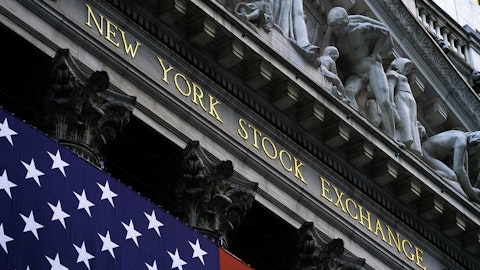In this article, we discuss the 12 lowest PE ratio S&P 500 stocks.
The S&P 500 headed into September 2025 following robust gains, yet investor sentiment was mixed since it is a month that has historically been weak for equities. September has been the worst-performing month over the past decade, with an average return of about -2%, and the index fell in six of the last ten Septembers.
Despite potential near-term volatility, UBS analysts suggest that investors who have less exposure to stocks should consider incrementally raising it and using market dips as buying opportunities. UBS expects the S&P 500 to reach 6,800 by the end of June 2026, around 5% higher, based on several factors. Most companies in the S&P 500 have reported Q2 2025 earnings, with 81% beating Wall Street expectations, while third-quarter guidance is also favorable.
Similarly, top brokerages are feeling more optimistic about the S&P 500, pointing to strong corporate earnings and a stable American economy, even though some companies warn about the harrowing impacts of tariffs. The difference between positive broker targets and cautious company signals means the market may depend on how well businesses handle these tariffs.
With that outlook in mind, let’s take a look at the S&P 500 stocks with a low PE ratio.

Photo by Pascal Bernardon on Unsplash
Our Methodology
For this article, a stock screener was used to identify S&P 500 companies. The stocks were then sorted by ascending P/E ratios, and the 12 with the lowest ratios as of September 30 were chosen. Additionally, hedge fund sentiment for these holdings from the June quarter is included to provide further context. The list is ranked according to hedge fund data, from lowest to highest.
Why are we interested in the stocks that hedge funds pile into? The reason is simple: our research has shown that we can outperform the market by imitating the top stock picks of the best hedge funds. Our quarterly newsletter’s strategy selects 14 small-cap and large-cap stocks every quarter and has returned 373.4% since May 2014, beating its benchmark by 218 percentage points (see more details here).
12. APA Corporation (NASDAQ:APA)
Number of Hedge Fund Holders: 33
PE Ratio as of September 30: 8.30
APA Corporation (NASDAQ:APA) is a Texas-based energy company that explores, develops, and sells natural gas, crude oil, and natural gas liquids. It operates oil and gas projects in the United States, Egypt, and the North Sea.
During the second quarter of 2025, APA started cutting its Permian rig count from eight to six, showing improvements in drilling efficiency. The company now expects to keep oil production in the Permian steady at six rigs, down from the 6.5 rigs planned in May. Better capital efficiency in the Permian has lessened the original capital forecast by $130 million, while keeping the same oil production targets, after adjusting for the disposal of the New Mexico asset in mid-June.
In addition to being one of the S&P 500 stocks with a low P/E ratio, APA provides a steady stream of dividend payouts to its investors. The company has issued cash dividends on its common stock since 1965. On September 9, APA Corporation (NASDAQ:APA) declared a quarterly dividend of $0.25 per share, which is distributable on November 21 to shareholders listed as of October 22. During the June quarter, the company returned $140 million to shareholders through its standard dividend and stock repurchase initiatives. It has a dividend yield of 4.05% as of September 30.
11. Conagra Brands, Inc. (NYSE:CAG)
Number of Hedge Fund Holders: 38
PE Ratio as of September 30: 7.56
Conagra Brands, Inc. (NYSE:CAG) is one of the S&P 500 stocks with a low PE ratio. On September 24, Evercore ISI reiterated an In Line rating on CAG while slashing the target price from $24 to $23.
Evercore lowered its price target following a drop in its FY2026 EPS from $1.82 to $1.79, reflecting a 22% year-over-year dip. The firm pointed to higher commodity inflation, particularly in beef, as the main factor leading to the downward revision.
The research firm mentioned that fiscal year 2026 is another year of change for Conagra, pointing towards challenges such as rising expenses, potential tariffs, impacts from divesting brands, and investments in price and promotion strategies.
According to Evercore ISI, it will wait to see if Conagra can regain organic sales growth heading into FY 2027, with a spotlight on the Frozen and Snacks segments, which contribute to roughly two-thirds of sales.
The $23 price target equals 12 times the firm’s projected 2027 EPS, indicating a slight discount compared with Conagra’s five-year average PE ratio of 13x, which has ranged from 10x to 16x.
Conagra Brands, Inc. (NYSE:CAG) is an American food company that sells packaged consumer products. It has four main segments: Grocery & Snacks, Refrigerated & Frozen, International, and Foodservice.
10. Molson Coors Beverage Company (NYSE:TAP)
Number of Hedge Fund Holders: 37
PE Ratio as of September 30: 8.63
Molson Coors Beverage Company (NYSE:TAP) ranks 10th on our list of the S&P 500 stocks with a low PE ratio. Molson Coors makes and sells beer and other malt drinks around the world, including hard seltzers, craft beers, spirits, and ready-to-drink beverages.
On September 30, Piper Sandler maintained a Neutral rating on TAP and trimmed the price target from $53 to $52. The research firm pointed to current challenges and a lack of immediate growth stimulators, aside from a potential boost in American consumer spending, which has not yet materialized.
The new price target equals a PE ratio of about 9x, topping the five-year historical average of 7.6x as well as the current figure. Despite the difficult environment, the company maintains a 4.11% dividend yield and a 51-year track record of dividend payouts
Piper Sandlet also highlighted ongoing pressure on revenue growth in both the United States and EMEA markets, which it expects to continue in the near term. The firm revised its Q3 2025 Americas organic sales decline forecast down by about 1% to align with the current retail environment.
Even though on-premise sales might be picking up pace, Molson Coors’ overall volumes are expected to stay under pressure at least until 2026. Due to this, Piper Sandler lowered its EPS estimates, cutting the 2025 and 2026 forecasts to $5.43 and $5.75, respectively, which resulted in a lower price target.
9. Edison International (NYSE:EIX)
Number of Hedge Fund Holders: 42
PE Ratio as of September 30: 8.02
Edison International (NYSE:EIX) is one of the S&P 500 stocks with a low PE ratio. On September 17, concerns over a diminishing wildfire fund led S&P Global Ratings to downgrade Edison International from BBB to BBB- with a negative outlook.
S&P lowered the rating based on forecasts that California’s wildfire fund will not touch prior projections. While Senate Bill 254 authorizes an $18 billion increase through a continuation account, the net present value provides only $10.5 billion more.
S&P estimates that after financing the Eaton Fire obligations, the remaining fund will be about 70-75% of the original $21 billion, which amounts to around $14 billion-$16 billion, thereby impacting Edison’s credit quality.
The firm revised Edison’s comparable rating analysis modifier to negative from neutral, emphasizing that a stable $20 billion wildfire fund is necessary to preserve credit quality without additional substantial changes.
According to S&P, utilities were not meant to be the ultimate vehicles for wildfire prevention, as they generate modest 9-11% returns on equity and maintain roughly 50% leverage. The agency suggested that industries such as insurance, which have lower financial leverage, are better positioned to handle these risks.
The agency continues to consider Edison’s financial risk as crucial, expecting its FFO-to-debt ratio to improve in 2025, supported by larger cash collections from balancing accounts, about $1.6 billion in securitization proceeds from past fire events, and projected constructive regulatory outcomes.
Edison International (NYSE:EIX) produces and delivers electricity across nearly 50,000 square miles in southern California, catering to homes, businesses, industries, public authorities, and farms.
8. Eastman Chemical Company (NYSE:EMN)
Number of Hedge Fund Holders: 43
PE Ratio as of September 30: 8.71
Eastman Chemical Company (NYSE:EMN) ranks 8th on our list of the S&P 500 stocks with a low PE ratio. On August 14, S&P Global Ratings downgraded EMN’s outlook to Negative from Stable, noting that there are sector pressures. The firm kept its ‘BBB’ rating intact.
According to the rating agency, trade tensions and tariffs are anticipated to exert more pressure on product demand and shake up Eastman’s 2025 performance. During its Q2 earnings call, the company noted that American tariffs and retaliatory measures have made operations tougher, worsening demand that has already been lagging for two years.
Eastman is adjusting its global inventory and material distribution, focusing on early sales in cyclical end markets, including construction, automotive, and consumer durables, to combat tariff pressures. The company expects mid-single-digit percentage drops in H2 2025.
S&P expects that Eastman’s FFO-to-debt ratio could reach 21% this year, the lower bound for the current rating. The company also faces multiple profit challenges in 2025. The company’s commodity chemicals business is also suffering from Chinese production, with management citing export market strain.
The negative outlook reflects a roughly 33% risk that Eastman’s credit metrics could weaken below rating standards in the next two years. S&P estimates that cash from operations will potentially drop to nearly $1 billion in 2025, down $200 million from the last guidance, following $1.1 billion in 2023 and $1.3 billion in 2024.
Eastman Chemical Company (NYSE:EMN), founded in 1920 and based in Tennessee, is a specialty materials company operating globally, with business segments including Additives & Functional Products, Advanced Materials, Chemical Intermediates, and Fibers.
7. Bunge Global SA (NYSE:BG)
Number of Hedge Fund Holders: 44
PE Ratio as of September 30: 8.16
Bunge Global SA (NYSE:BG), founded in 1818 and based in Missouri, is a global agribusiness and food company. Its main segments are Agribusiness, Refined and Specialty Oils, Milling, and Sugar and Bioenergy. It ranks 7th on our list of the S&P 500 stocks with a low PE ratio.
On September 8, UBS maintained a Buy rating and a $100 price target on BG, after meeting the company’s management at the UBS Materials Conference.
According to UBS analyst Manav Gupta, Bunge expects the final Renewable Volume Obligation (RVO) and Small Refinery Exemption (SRE) reallocation decisions by December 2025, with a favorable outcome possibly due to the tight collaboration between the Environmental Protection Agency (EPA) and the US Department of Agriculture (USDA) to support farmers.
Gupta highlighted that eliminating the Indirect Land Use Change penalty for soybean oil enhances its Carbon Intensity rating, placing it on even footing against feedstocks like tallow and recycled cooking oil.
Bunge expects soybean oil demand to rise in 2026 and 2027, since foreign feedstocks have no production tax credit and only 50% of Renewable Identification Numbers. Bunge plans to release updated 2025 earnings guidance incorporating Viterra, with UBS expecting re-segmentation to be evident in Q3 2025 results.
6. Synchrony Financial (NYSE:SYF)
Number of Hedge Fund Holders: 45
PE Ratio as of September 30: 8.65
Synchrony Financial (NYSE:SYF) is one of the S&P 500 stocks with a low PE ratio. On September 25, JMP Securities maintained a Market Outperform rating on SYF and lifted the price target from $77 to $88.
The price target adjustment followed encouraging management statements at recent conferences, where Synchrony executives reported strong credit results through August.
While company management reiterated its 2025 guidance, JMP upgraded its 2026 EPS estimate from $8.82 to $9.04. The research firm lifted its target 2026 EPS multiple from roughly 9x to 10x, citing clearer signs that differentiated partnerships on Synchrony’s platform offer a notable advantage against BNPL competitors.
Synchrony Financial (NYSE:SYF) is a Connecticut-based consumer financial services company that offers credit products, commercial credit, and installment loans, alongside deposit products such as savings accounts, IRAs, and money market accounts.
5. Delta Air Lines, Inc. (NYSE:DAL)
Number of Hedge Fund Holders: 49
PE Ratio as of September 30: 8.11
Delta Air Lines, Inc. (NYSE:DAL) is one of the S&P 500 stocks with a low PE ratio. On September 11, Delta reiterated its full-year and present-quarter earnings outlook, expecting American travel demand to remain steady.
The airline raised the minimum estimate of its Q3 revenue forecast through September to 2%, up from 0%, while maintaining the maximum projection at 4%.
This favorable sentiment stands in clear contrast to the beginning of the year, when US carriers estimated lower travel demand amid Trump’s tariffs and spending cuts.
Air travel demand has rebounded, with airline executives in July optimistic about the industry’s capacity to increase ticket prices toward year-end. According to the latest data from the Bureau of Labor Statistics, airfares climbed 4% in July, while holiday periods saw more Americans taking advantage of travel discounts for domestic and international flights.
Delta Air Lines, Inc. (NYSE:DAL), established in 1924 and headquartered in Atlanta, Georgia, is a global provider of passenger and cargo air transportation.
4. Charter Communications, Inc. (NASDAQ:CHTR)
Number of Hedge Fund Holders: 56
PE Ratio as of September 30: 7.75
Charter Communications, Inc. (NASDAQ:CHTR) is a leading American broadband and cable operator serving both residential and commercial clients, offering subscription-based internet, video, mobile, and voice services.
On September 10, Bernstein SocGen reaffirmed an Outperform rating on CHTR but trimmed the price target to $350 from $380. As per the research firm, the price target adjustment came in light of anticipated higher broadband losses and persistent competition from fixed wireless access services.
Analysts suggested that short-term competitive pressures may impact Charter’s recovery and result in larger marketing expenditures.
Despite headwinds and mounting competitive pressures, the firm maintained an Outperform rating on Charter, based on estimated stable or increasing revenue and EBITDA. Bernstein’s investment case also accounts for notably higher free cash flow due to declining capital spending in 2026 and more so in 2027.
3. Devon Energy Corporation (NYSE:DVN)
Number of Hedge Fund Holders: 58
PE Ratio as of September 30: 8.13
Devon Energy Corporation (NYSE:DVN) is one of the S&P 500 stocks with a low PE ratio. Devon Energy, an independent Oklahoma-based energy firm, is involved in the exploration, development, and production of oil, natural gas, and natural gas liquids.
On September 5, Raymond James boosted the target price on DVN from $45 to $46, while assigning an Outperform rating to the stock.
Raymond James updated its estimates based on present commodity prices, following Devon’s outperformance of production and capex forecasts by the research firm itself and Wall Street by 2% and 7% respectively, along with a second consecutive $100 million slash in 2025 capex.
Raymond James observed that $75 million of DVN’s $100 million capex reduction stems from its current optimization program. The company further estimates around $1 billion in extra free cash flow over the next three years from reduced cash taxes and an additional $50 million per year from purchasing the remainder of the non-controlling interests in Cotton Draw Midstream.
For Q3 2025, the firm forecasts production of about 837,000 barrels of oil equivalent daily, including 387,000 barrels of oil and capex of $908 million, in line with guidance and analyst expectations. Full-year 2025 production of nearly 833,000 BOE/day and $3.7 billion in capital expenditure are also in accordance with consensus estimates.
Raymond James also expects Devon Energy Corporation (NYSE:DVN) to achieve free cash flow yields of about 9% in 2025 and 10% in 2026, similar to peers, with a 2026 EV/EBITDA projected at 4.2x versus roughly 4.5x for peers. The new price target is an indicator of greater capital efficiency by DVN.
2. Centene Corporation (NYSE:CNC)
Number of Hedge Fund Holders: 59
PE Ratio as of September 30: 8.54
Centene Corporation (NYSE:CNC) is one of the S&P 500 stocks with a low PE ratio. On September 16, Cantor Fitzgerald assigned a Neutral rating to CNC along with a $38 price target.
The firm noted that finalized rates usually match payor proposals but are less than the desired 30%+ increases for 2026, which resulted in a cautious market outlook. Centene, a major player in the Healthcare Providers & Services industry, has a strong financial profile, controlled debt, and a PE ratio of 8.03x.
According to Cantor Fitzgerald, an analysis of the first 15 states with finalized rates demonstrates that payors’ final rates are within nearly 1% of their initial proposals, while Centene’s final rates were about 30 basis points higher. The research firm identified less-responsive states, noting a huge discrepancy in New York, where Centene’s proposed 8.1% increase was finalized at only 2.9%.
The market climate remains uncertain due to political instability, particularly around the CMS Marketplace Integrity & Affordability Final Rule and the upcoming expiration of premium-enhanced subsidies at year-end.
Centene Corporation (NYSE:CNC) is a healthcare company providing services to under-insured and uninsured individuals, as well as commercial organizations in the United States.
1. Comcast Corporation (NASDAQ:CMCSA)
Number of Hedge Fund Holders: 82
PE Ratio as of September 30: 5.26
Comcast Corporation (NASDAQ:CMCSA) ranks 1st on our list of the S&P 500 stocks with a low PE ratio. Comcast announced the deployment of country-wide AI-driven network amplifiers on September 26, which the company touts as the industry’s largest rollout of this category.
Comcast’s new intelligent amplifiers are placed at the edge of its network, moving AI functions closer to end users. They are capable of self-monitoring, self-healing, and self-maintenance, offering real-time decision-making ability at the network edge.
This initiative is part of Comcast’s ongoing Project Genesis, intended to virtualize its network infrastructure. It currently caters to more than half of the service area, with the coverage perimeter expected to increase to 70% by the end of 2025.
According to Comcast, its AI systems analyze 10,000 data points per hour across 30 million network devices to optimize in-home WiFi. The technology additionally investigates outages in extreme weather and enhances capacity on demand during unforeseen hikes in traffic.
The amplifiers introduce new capabilities, such as self-directed AI that can recognize fiber outages and automatically redirect traffic during maintenance. Additional AI systems are being tested to spot cyber threats or optimize energy use based on consumption insights.
While we acknowledge the potential of CMCSA to grow, our conviction lies in the belief that some AI stocks hold greater promise for delivering higher returns and have limited downside risk. If you are looking for an AI stock that is more promising than CMCSA and that has 100x upside potential, check out our report about this cheapest AI stock.
READ NEXT: 20 Best AI Stocks To Buy Now and 30 Best Stocks to Buy Now According to Billionaires.
Disclosure: None. Insider Monkey focuses on uncovering the best investment ideas of hedge funds and insiders. Please subscribe to our free daily e-newsletter to get the latest investment ideas from hedge funds’ investor letters by entering your email below.





